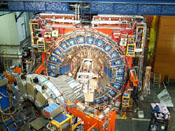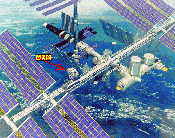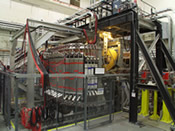Laboratory for Nuclear Science
The Laboratory for Nuclear Science (LNS) provides support for research by faculty and research staff members in the fields of high-energy and nuclear physics. These activities include those at the Bates Linear Accelerator Center and in the Center for Theoretical Physics. Almost half of the faculty in the Department of Physics conduct their research through LNS. During fiscal year 2003, the Department of Energy is expected to provide LNS a total of $27,849,000 in research funding.
Experimental High-Energy Physics
LNS researchers in experimental high-energy physics are active at several laboratories, including the Stanford Linear Accelerator Center (SLAC) and Fermilab (Illinois). The overall objective of current research in high-energy physics is to test as precisely as possible the Standard Model, which has been very successful in describing a wide variety of phenomena, and to seek evidence for physics beyond the Standard Model. LNS researchers are playing principal roles in much of this research, as described below.
LNS researchers are playing leading roles in the BaBar experiment at SLAC, which has yielded important insights into the nature of charge symmetry/parity violation in the B-meson system.
 Collider Detector Facility at Fermilab in Batavia, IL |
The Collider Detector Facility (CDF) experiment at Fermilab is designed to study the Standard Model and its possible extensions at the Tevatron collider, the highest energy accelerator in the world. Current objectives of CDF include studies of the "bottom" (b) quark, searches for new particles and interactions, and a search for magnetic monopoles. After a major upgrade, in which LNS researchers assumed important responsibilities, the multiyear Collider Run II is now producing data.
In 2007–2008, the high-energy frontier will shift to CERN (European Organization for Nuclear Research) in Geneva, Switzerland, when the Large Hadron Collider (LHC) commences operation. LNS is involved in both large detector projects at the LHC: the Compact Muon Solenoid (CMS) and A Toroidal LHC Apparatus (ATLAS) detectors. In CMS, LNS scientists are engaged in the development of the data acquisition system; in ATLAS the effort is mainly in the development of the muon detection systems. LNS scientists are leading the program to study high-energy heavy ion collisions with CMS.
 Alpha Magnetic Spectrometer (AMS) on the International Space Station |
The Alpha Magnetic Spectrometer (AMS) experiment is designed to look for cosmic antimatter and evidence for dark matter by operating a large magnetic spectrometer above the Earth's atmosphere. The international AMS collaboration is composed primarily of particle physicists and is led by an LNS group. An upgraded version of the AMS spectrometer is under construction, and the experiment is scheduled for a several-year data-taking period on the International Space Station starting in 2005.
Experimental Nuclear Physics
Experimental nuclear physics at present has two main thrusts: medium-energy physics and heavy-ion physics. LNS has active, leading groups in both of these subfields.
 Bates Large Acceptance Spectrometer Toroid (BLAST) |
The focus of LNS medium-energy activities is the Bates Linear Accelerator Center, which is operated by LNS for the Department of Energy as a national user facility. Bates has been a premier national and international resource for nuclear and particle physics studies for more than two decades. Continuous (as opposed to pulsed) electron beams in the South Hall Ring have been produced in both storage and stretcher modes. Extracted, stretched beam has been used in two highly successful experiments with the Out-of-Plane Spectrometer system, which probed different aspects of the structure of the proton. The major accomplishments of the past year have been the completion of an experiment on parity-violating electron scattering, which probes the role of the "strange" quark in the proton, and the completion of the commissioning of the Bates Large Acceptance Spectrometer Toroid (BLAST) detector. Together with polarized, stored beams and polarized targets, BLAST is entering its data-taking phase, and results of unprecedented quality are expected within a year.
LNS nuclear physics researchers are leading several important efforts at accelerator facilities other than Bates. These facilities include the Thomas Jefferson National Accelerator Facility (Virginia), the Los Alamos Neuron Science Center (New Mexico), Deutsches Elektronen Synchroton (DESY, Germany), and Mainz (Germany). The focus of these experiments is a detailed understanding of the properties of the proton, the neutron, and light nuclei.
LNS researchers are prominent in relativistic heavy-ion physics. The principal goal of this field is to probe the existence and properties of the "quark-gluon plasma"—a state of matter that is predicted to exist at temperatures and densities higher than those present in normal matter and that may have been present in the very early universe. An LNS group leads the Phobos experiment on the Relativistic Heavy Ion Collider (RHIC) at Brookhaven.
Theoretical Nuclear and Particle Physics
Research at the Center for Theoretical Physics (CTP) seeks to extend and unify our understanding of the fundamental constituents of matter. It seeks to advance the conceptual foundations of fundamental physics, especially as applied to the structure and interactions of hadrons and nuclei, new forms of matter that may be created experimentally or observed astrophysically, and the history and large-scale structure of the universe. Following are a few examples of recent work.
String theory aims to unite the strong, electroweak, and gravitational interactions and to explain the observed hierarchy of particles and interactions. The CTP has a strong and diverse group in string theory, with important ties to particle physics. Important work includes the study of instabilities of "branes"—extended objects that occur in string theory—and their implications for field theories of strings. CTP theorists are also very active in the exploration of matrix quantum mechanics, which may be the fundamental structure that unifies various versions of string theory, and the study of tantalizing connections between string theories in anti–de Sitter space and conformal quantum field theories.
String theories suggest patterns of supersymmetry breaking that may have implications for physics at the energy scales of the next accelerators. CTP researchers have been exploring these patterns. Also, string theory and quantum gravity suggest that space-time may have other dimensions that influence physical phenomena only indirectly. Predicted effects include manifestations of extra dimensions at energies quite close to those presently available at accelerators.
MIT theorists have been actively developing new calculational tools for the study of nonperturbative phenomena in quantum field theories. Variational methods, consistent with renormalization and adapted for easy numerical computation, have been developed and are being applied to problems that arise in the Standard Model.
A major effort in the CTP has been in the area of lattice gauge theory, which provides a unique tool to solve rather than model quantum field theories beyond perturbation theory. The CTP led the development of a national collaboration on high-speed computation in quantum chromodynamics (QCD), which receives funding as part of the Department of Education's Scientific Discovery through Advanced Computing initiative. These efforts parallel a new thrust in the study of QCD at finite density and pressure. CTP researchers have suggested novel effects such as "color superconductivity" and explained how they may be observed in heavy-ion collisions.
CTP researchers continue to lead the exploration of the spin and flavor structure of hadrons, as seen in experiments (many led by MIT faculty) at Bates, Jefferson Laboratory, DESY, and Brookhaven National Laboratory.
Finally, the CTP has initiated important work in quantum computing. New algorithms that exploit the adiabatic approximation in quantum mechanics offer hope of solving generic problems much faster than classical methods.
Education
Since its founding, LNS has placed education at the forefront of its goals. At present, approximately 72 graduate students are receiving their training through LNS research programs. A number of undergraduate students are also heavily involved in LNS research. LNS has educated a significant portion of the leaders of nuclear and high-energy physics in this country and abroad.
More information about the Laboratory for Nuclear Science can be found on the web at http://www-lns.mit.edu/.